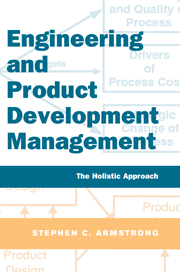Book contents
- Frontmatter
- Contents
- List of figures and tables
- Forewords
- Preface
- Acknowledgments
- Layout of book at a glance
- PART 1 UNDERSTANDING ENGINEERING PROCESS MANAGEMENT
- PART 2 APPLYING ENGINEERING PROCESSES TO PROGRAM MANAGEMENT
- PART 3 DEPLOYING ENGINEERING PROCESS MANAGEMENT
- 12 Organizing for deployment
- 13 Overcoming resistance to change
- 14 Implementing IPD – Lessons learned case study
- PART 4 APPENDIXES
- Glossary
- References
- Index
13 - Overcoming resistance to change
Published online by Cambridge University Press: 05 April 2014
- Frontmatter
- Contents
- List of figures and tables
- Forewords
- Preface
- Acknowledgments
- Layout of book at a glance
- PART 1 UNDERSTANDING ENGINEERING PROCESS MANAGEMENT
- PART 2 APPLYING ENGINEERING PROCESSES TO PROGRAM MANAGEMENT
- PART 3 DEPLOYING ENGINEERING PROCESS MANAGEMENT
- 12 Organizing for deployment
- 13 Overcoming resistance to change
- 14 Implementing IPD – Lessons learned case study
- PART 4 APPENDIXES
- Glossary
- References
- Index
Summary
Managing the transition from the current to a new product development process is a difficult job. One of the most critical elements of that transition is implementing a newteam-based approach. Realizing tangible benefits from a team-based approach does not come easily. Resistance to change can emerge from all areas of the organization.
This aspect of the management process has consistently been a weakness for engineering-driven companies. Engineers are notorious for resisting cultural change. Traditionally, engineers focus on scientific concepts and “things” rather than emotions and people. The transition to top management is not an easy road for the typical engineer. In this chapter, we discuss the “soft” side of management. At the heart of any change initiative is balance between business needs, individual needs, and organizational politics.With the right help, this balance can be found by a company undergoing change. The organization can be improved by “engineering” the right processes, measures, technologies, and culture. Collective behavior can be predicted by the trained mind. Politics can be engineered to allow the improvement initiative to succeed. But these skills are rarely taught in engineering or business schools.
ORGANIZATIONAL POLITICS
The approach to changing the culture will need to be outside the normal project approach for an organization. To capture the organization's attention will require choosing methods that stand in stark contrast to standard operating procedures.
- Type
- Chapter
- Information
- Engineering and Product Development ManagementThe Holistic Approach, pp. 208 - 237Publisher: Cambridge University PressPrint publication year: 2001

